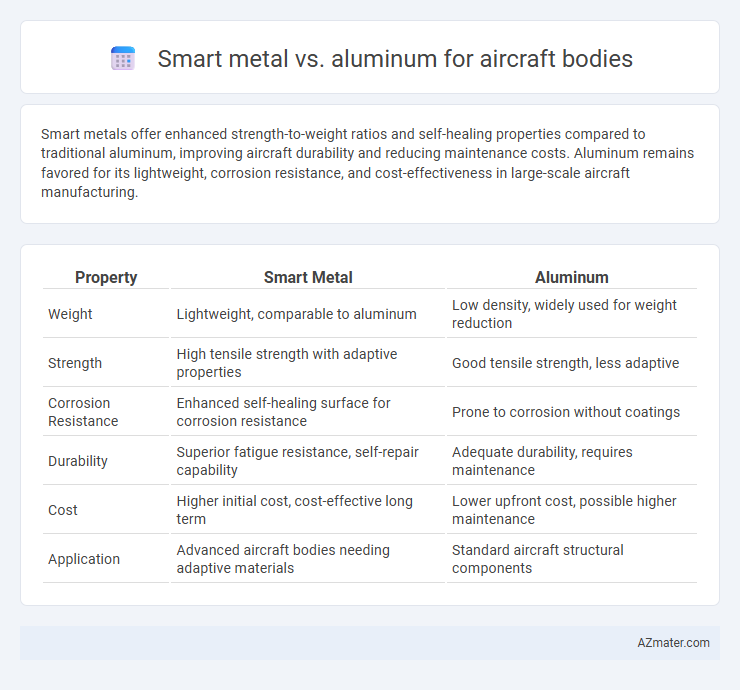Smart metals offer enhanced strength-to-weight ratios and self-healing properties compared to traditional aluminum, improving aircraft durability and reducing maintenance costs. Aluminum remains favored for its lightweight, corrosion resistance, and cost-effectiveness in large-scale aircraft manufacturing.
Table of Comparison
| Property | Smart Metal | Aluminum |
|---|---|---|
| Weight | Lightweight, comparable to aluminum | Low density, widely used for weight reduction |
| Strength | High tensile strength with adaptive properties | Good tensile strength, less adaptive |
| Corrosion Resistance | Enhanced self-healing surface for corrosion resistance | Prone to corrosion without coatings |
| Durability | Superior fatigue resistance, self-repair capability | Adequate durability, requires maintenance |
| Cost | Higher initial cost, cost-effective long term | Lower upfront cost, possible higher maintenance |
| Application | Advanced aircraft bodies needing adaptive materials | Standard aircraft structural components |
Introduction to Aircraft Body Materials
Smart metals such as shape memory alloys offer high strength-to-weight ratios and the ability to undergo deformation and return to their original shape, providing durability and adaptive performance in aircraft structures. Aluminum, traditionally used in aircraft bodies, is prized for its lightweight properties, corrosion resistance, and ease of fabrication, making it a standard choice in aerospace engineering. The evolving demands for fuel efficiency and structural resilience drive the integration of smart metals alongside aluminum to optimize aircraft body materials.
Overview of Smart Metals
Smart metals in aircraft bodies refer to advanced materials that adapt to environmental changes, enhancing structural integrity and reducing maintenance costs. Unlike traditional aluminum, smart metals incorporate properties such as shape memory, self-healing, and corrosion resistance, providing superior fatigue life and weight efficiency. These innovative alloys and composites optimize aerodynamic performance while enabling real-time health monitoring in modern aerospace engineering.
Properties of Aluminum in Aviation
Aluminum exhibits an exceptional strength-to-weight ratio, making it a preferred material for aircraft bodies due to its ability to withstand aerodynamic stresses while minimizing overall weight. Its high corrosion resistance enhances durability in varying atmospheric conditions, extending the lifespan of airframes and reducing maintenance costs. Aluminum's excellent machinability and formability allow for efficient manufacturing of complex aircraft structures, contributing to optimized fuel efficiency and performance.
Strength and Durability Comparison
Smart metals, such as titanium alloys and advanced composites, offer superior strength-to-weight ratios compared to traditional aluminum used in aircraft bodies. Titanium alloys provide exceptional fatigue resistance and corrosion durability, enhancing the aircraft's longevity under cyclic stress conditions. Aluminum remains favored for its lightweight properties and ease of fabrication but generally exhibits lower tensile strength and is more susceptible to corrosion over time than smart metal alternatives.
Weight and Fuel Efficiency
Smart metal alloys designed for aircraft bodies offer superior strength-to-weight ratios compared to traditional aluminum, significantly reducing overall aircraft weight. This weight reduction directly enhances fuel efficiency by lowering drag and the power required for flight. Consequently, smart metals contribute to longer flight ranges and reduced operational costs in aviation.
Corrosion Resistance and Maintenance
Smart metals in aircraft bodies offer superior corrosion resistance compared to traditional aluminum, significantly reducing the frequency and cost of maintenance. These advanced alloys often incorporate protective coatings and self-healing properties that prevent oxidation and electrolyte penetration. In contrast, aluminum requires regular inspections and treatments to combat corrosion, increasing long-term maintenance efforts and expenses.
Manufacturing and Scalability
Smart metals, such as shape memory alloys, offer advanced adaptability and self-healing properties, enhancing aircraft durability but require complex manufacturing processes that increase production costs. Aluminum remains the preferred material for scalability due to its lightweight nature, ease of machining, and widespread availability, facilitating large-scale fabrication with established supply chains. Manufacturing with aluminum supports rapid production cycles and cost efficiency, whereas smart metals are currently limited by slower, more specialized manufacturing techniques.
Cost Analysis: Smart Metal vs Aluminum
Smart metal offers significant cost advantages over aluminum for aircraft bodies due to its enhanced durability and reduced maintenance requirements, leading to lower lifecycle expenses. While aluminum remains less expensive upfront, smart metal's resistance to corrosion and superior strength-to-weight ratio minimizes repair costs and extends service intervals. The overall cost analysis reveals that smart metal can reduce total operational costs despite higher initial investment.
Environmental Impact and Sustainability
Smart metals, such as shape memory alloys, offer enhanced durability and corrosion resistance that can extend aircraft lifespan, reducing the frequency of replacements and associated resource consumption. Aluminum remains a lightweight, highly recyclable material with a well-established recycling infrastructure, minimizing environmental impact through efficient material reuse. Choosing smart metals or aluminum involves balancing superior performance benefits against the established sustainability of aluminum's low-energy recycling processes.
Future Trends in Aircraft Body Materials
Future trends in aircraft body materials emphasize the development of smart metals with adaptive properties such as self-healing and real-time stress monitoring, offering enhanced durability and safety compared to traditional aluminum alloys. Advanced aluminum composites continue to evolve, providing lightweight strength and corrosion resistance while integrating sensor technologies for improved structural health monitoring. Innovations in nanotechnology and material science drive the shift towards multifunctional materials combining the best attributes of smart metals and aluminum for next-generation aerospace applications.

Infographic: Smart metal vs Aluminum for Aircraft body
 azmater.com
azmater.com